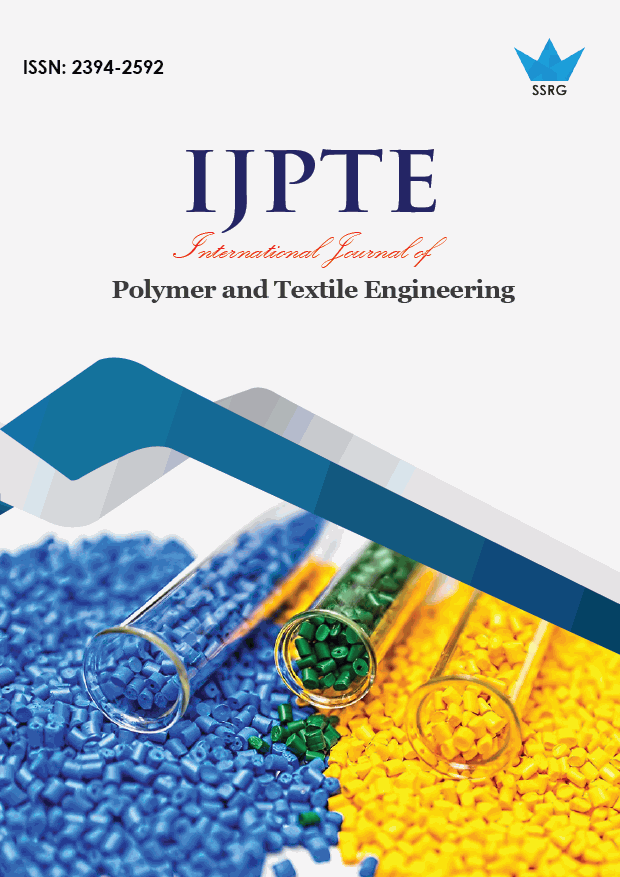Extraction and Evaluation of OKRA Fibres

| International Journal of Polymer and Textile Engineering |
| © 2019 by SSRG - IJPTE Journal |
| Volume 6 Issue 1 |
| Year of Publication : 2019 |
| Authors : N.Vasugi, S.Amsamani and R.Sunitha |
How to Cite?
N.Vasugi, S.Amsamani and R.Sunitha, "Extraction and Evaluation of OKRA Fibres," SSRG International Journal of Polymer and Textile Engineering, vol. 6, no. 1, pp. 24-30, 2019. Crossref, https://doi.org/10.14445/23942592/IJPTE-V6I1P105
Abstract:
The mother earth is filled with huge amount of fibrous material to satisfy all needs of mankind. Till date, even the highest level of technological innovation has not taped every source considerably. Considerably this, a research is framed on okra fibres. To overcome the problem of shortage of natural fibres and to utilize the underutilized fibres, on the earth, a study on extraction and analysis of fibres from Okra plant was carried out. The world has turned its attention to renewable and sustainable resources. The preparation of characterization of cellulose – based materials is important in research and development area. It is botanically called as Abelmoschus esculentus. The Okra fibres were extracted from the stalk of the plant which was given alkali and acid treatments to study the salient fibre properties such as chemical constituents, weight loss, burning behavior and moisture content. The Scanning Electron Microscopy (SEM) study was also carried out to assess the morphological changes in ,the fibres on processing. Fourier transform infrared spectroscopy (FTIR) test was also carried out to find the presence of the chemical groups in the fibres before and after treatments. The study has thrown light to give better scope for okra fibres in the use of textiles
Keywords:
Okra, Fibre Property, Fibre, Chemical Constituent, Moisture Content, Scanning Electron Microscopy, Fourier Transform Infrared Spectroscopy and Weight Loss.
References:
[1] Srinivasababu.N, Murali Mohan.K , Rao and Suresh Kumar.J, 2009, Experimental determination of tensile properties of okra, sisal and banana fiber reinforced polyester, composites Indian Journal of Science and Technology Vol.2 No. 7 (July) ISSN: 0974- 6846.
[2] Chakma Koushik, Cicek Nazim and Rahman Mashiur, Bioengineering Fiber extraction efficiency, quality and characterization of cattail fibres for textile applications, The Canadian Society for engineering in agriculture, Agroalimentaire, Department of Biosystems Engineering, University of Manitoba, Paper No. CSBE17-025
[3] www.AsiaFarming.com.
[4] www.elsevir.com/locate/carbpol. “Chemical, morphology and thermal evaluation of cellulose microfibers obtained from Hibiscus sabdariffa”- A.Sonia, K.Priya Dasan* Material Chemistry Division SAS VIT University,Tamilnadu-632014.*Corresponding Author.
[5] https://diutestudents.blogspot.com/2018/04/moisture-regain-moisture-regain-is.html
[6] Khan Arifuzzaman G.M., Shaheruzzaman Md., Rahman M.H., Abdur Razzaque S.M., Sakinul Islam Md., & Shamsul Alam Md.2009, Surface modification of Okra Bast fiber and its Physico- chemical characteristic, Fibers of polymers , V0l.10, No.1, Pp.65-70.
[7] Corbman.P.Bernard, 1983, Textile Fiber to Fabric, 6th edition, Mc.Graw- Hill.Inc.
[8] Cao Yongjian, Felisa Chan Ying-Heivhui and Huining xiao, Bio Resources, properties and modified flax fibers 7(3), 4109-4121
[9] http://textilelearner.blogspot.com/2013/03/an-overview-of-textile-scouring-process.html)
[10] ASTM D 1776/D1776M -16. 2017. Standard Practice for Conditioning and Testing Textiles, access, online at https://compass- astorg.uml.idm.oclc.org/download/D1776D1776M.37275.pdf

 10.14445/23942592/IJPTE-V6I1P105
10.14445/23942592/IJPTE-V6I1P105